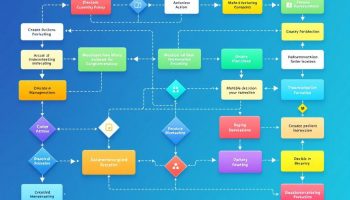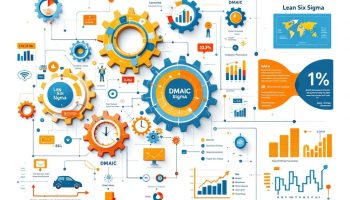
The Difference Between Kaizen and Six Sigma
The difference between Kaizen and Six Sigma reveals two distinct approaches to process improvement, each with unique origins and core principles. Kaizen developed in Japan as a philosophy focused on continuous, small improvements through employee engagement. Six Sigma, created at Motorola during the 1980s, relies on data analysis and statistical methods to reduce defects.
Key Takeaways:
- Kaizen encourages daily, incremental improvements initiated by staff across all levels, while Six Sigma employs structured projects managed by certified specialists.
- Kaizen needs minimal financial commitment and transforms organizational culture, whereas Six Sigma requires substantial investment in training and resources to address complex issues.
- Implementation timelines differ significantly—Kaizen can be adopted quickly, but Six Sigma projects typically span months to complete.
- Companies can benefit from combining both methods, using Kaizen for ongoing cultural enhancement and Six Sigma for technical challenges requiring detailed analysis.
- For either approach to succeed, you’ll need committed leadership, defined performance indicators, and alignment with company objectives.
“Kaizen and Six Sigma, while rooted in distinct philosophies, unite organizations in their pursuit of excellence: Kaizen’s embrace of incremental growth empowers every employee, while Six Sigma’s data-driven precision tackles complex challenges. Together, they form a powerful synergy that fosters both a culture of continuous improvement and a disciplined approach to problem-solving.”
Origins and Core Philosophies
Understanding what is the difference between Kaizen and Six Sigma begins with their distinct origins and philosophical foundations. Kaizen emerged from Japan as a philosophy meaning “change for the better” or “continuous improvement.” Developed within Toyota’s production system after World War II, it focuses on making small, incremental improvements consistently over time.
Kaizen centers on engaging every employee in the improvement process, regardless of their position. This bottom-up approach encourages workers to identify inefficiencies and suggest improvements in their daily work. By empowering team members at all levels, organizations create a culture where continuous improvement becomes second nature rather than a formal initiative.
Six Sigma, by contrast, originated at Motorola in the 1980s as a data-driven methodology to reduce defects and minimize process variation. It was later popularized by General Electric under Jack Welch’s leadership. Unlike Kaizen’s incremental approach, Six Sigma employs rigorous statistical analysis to achieve near-perfect processes with 3.4 defects per million opportunities.
Fundamental Differences in Approach
The key distinctions between these methodologies are evident in how they approach process improvement:
- Kaizen emphasizes:
- Continuous, small improvements made daily
- Cultural transformation and employee empowerment
- Simple tools accessible to all organization members
- Low-cost solutions that add up over time
- Six Sigma focuses on:
- Data-driven decision making and statistical analysis
- Structured problem-solving frameworks (DMAIC/DMADV)
- Significant, measurable improvements through projects
- Specialized practitioners with formal certification
When choosing between these methodologies, you’ll need to consider your organization’s culture and specific challenges. Many companies implement continuous improvement practices by combining elements from both approaches. For instance, you might use Kaizen principles for everyday improvements while applying Six Sigma methods to complex, persistent problems requiring deeper analysis.
The scale of implementation also differs significantly. Kaizen can be implemented with minimal training and investment, making it accessible to organizations of all sizes. Six Sigma typically requires a more substantial investment in training certified practitioners and implementing statistical measurement systems for risk response strategies.
Both methodologies share the ultimate goal of enhancing efficiency and reducing waste, but their paths to achieving that goal demonstrate what is the difference between Kaizen and Six Sigma in practical application.
Expert Insight: To effectively leverage process improvement methodologies, organizations must understand the foundational differences between Kaizen and Six Sigma. Kaizen promotes a culture of continuous, incremental improvements through employee engagement and low-cost solutions, making it accessible to all levels of an organization. In contrast, Six Sigma utilizes a data-driven, structured approach to problem-solving, emphasizing significant and measurable advancements led by certified practitioners, thereby requiring a more substantial investment in training and resources.
Methodological Approaches
Kaizen and Six Sigma differ fundamentally in their methodological approaches to process improvement. Understanding what is the difference between kaizen and six sigma helps you select the right methodology for your specific needs.
Kaizen employs a bottom-up, collaborative improvement strategy that empowers employees at all levels to identify and implement small, incremental changes. You’ll find this approach less formal but highly effective for creating a culture of continuous improvement. Kaizen tools include value stream mapping to visualize workflow, suggestion systems that capture employee ideas, and Kaizen events (rapid improvement workshops) that address specific processes over 3-5 days. With Kaizen, your team doesn’t need formal certification to participate in continuous improvement initiatives.
In contrast, Six Sigma uses a top-down, highly structured problem-solving methodology with specific frameworks. The primary Six Sigma approach follows the DMAIC model (Define, Measure, Analyze, Improve, Control) for existing processes, while DMADV (Define, Measure, Analyze, Design, Verify) is applied when creating new processes or products. Six Sigma requires formal certification with a belt-based hierarchy:
- Yellow Belt: Basic understanding of Six Sigma tools
- Green Belt: Can lead projects with part-time focus
- Black Belt: Full-time project leaders with advanced statistical training
- Master Black Belt: Organization-wide mentors and trainers
Six Sigma relies heavily on statistical tools and data analysis, including:
- Pareto charts that identify the vital few causes among many
- Control charts for monitoring process variation
- Root cause analysis to determine underlying issues
- Hypothesis testing to validate improvement impacts
The methodological contrast between what is the difference between kaizen and six sigma extends to implementation timeframes. Kaizen promotes daily improvements with project leadership distributed across teams, while Six Sigma employs longer-term projects (typically 3-6 months) led by certified specialists. Both approaches can deliver significant process improvements, but they differ in pace, structure, and execution style.
Organizations often find value in combining these methodologies, applying Kaizen for cultural transformation and everyday improvements while deploying Six Sigma for complex, data-heavy problems requiring rigorous statistical analysis. This integrated approach helps you leverage the strengths of each methodology while building a comprehensive process improvement program.
Expert Insight: When choosing between Kaizen and Six Sigma for process improvement, it’s crucial to align your methodology with your organizational needs. Kaizen fosters a culture of continuous improvement through employee empowerment and small, incremental changes, while Six Sigma emphasizes structured, data-driven problem-solving led by certified experts for more complex issues. To maximize effectiveness, consider integrating both approaches—utilizing Kaizen for daily enhancements and Six Sigma for significant, data-centric projects.
Industry Applications and Scope
You’ll find what is the difference between kaizen and six sigma most clearly demonstrated in how they’re applied across various industries. Both methodologies have found homes in different sectors, though with distinct approaches to process improvement.
Kaizen has gained significant traction in healthcare, manufacturing, and service industries where continuous, small improvements create substantial long-term value. Healthcare organizations implement kaizen to streamline patient flow, reduce wait times, and improve care quality through daily staff-driven improvements. Manufacturing companies utilize kaizen principles to eliminate waste, enhance production flow, and promote continuous improvement on the factory floor.
Six Sigma, with its rigorous statistical approach, is predominantly applied in:
- Manufacturing – reducing defects and variations in production processes
- Electronics – ensuring component reliability and precision
- Financial services – minimizing errors in transaction processing
- Healthcare – standardizing procedures to reduce medical errors
- Telecommunications – optimizing network reliability
The scope of these methodologies also differs significantly. Kaizen typically encompasses organization-wide improvement efforts that involve all employees regardless of position. It creates a culture where everyone contributes to ongoing enhancement of processes. Meanwhile, Six Sigma targets specific, measurable process improvements with the ambitious goal of achieving less than 3.4 defects per million opportunities.
Cross-Industry Implementation Considerations
When deciding between these methodologies, consider these industry-specific factors:
| Industry | Kaizen Approach | Six Sigma Approach |
|---|---|---|
| Healthcare | Daily improvement huddles, visual management | Data-driven patient flow optimization |
| Manufacturing | 5S workplace organization, waste reduction | Statistical process control, defect reduction |
| Service | Customer touchpoint improvements | Transaction error reduction, cycle time analysis |
| Technology | Rapid iteration cycles | Complex problem resolution through DMAIC |
The right methodology often depends on your organization’s needs. Service-oriented businesses with frequent customer interactions may benefit from kaizen’s continuous small improvements, while Six Sigma can address complex manufacturing issues where precise measurements and statistical analysis identify root causes. Many organizations find success by integrating both approaches – using kaizen for daily improvements and Six Sigma for tackling specific, complex problems requiring deeper analysis.
Organizations that embrace Kaizen and Six Sigma can achieve a 30-50% reduction in costs, leading to significant gains in customer satisfaction and operational efficiency.
forbes.com
Implementation Strategies
Understanding what is the difference between kaizen and six sigma becomes clear when examining their implementation approaches. These methodologies take distinctly different paths to process improvement.
Kaizen relies on continuous employee engagement across all levels of an organization. You’ll find this methodology emphasizes daily improvements rather than major overhauls. Implementation typically involves:
- Regular improvement events (Kaizen Blitzes) lasting 3-5 days
- Employee suggestion systems that encourage participation
- Visual management boards to track improvements
- Daily stand-up meetings to discuss ongoing enhancements
- Cultural emphasis on identifying and eliminating waste
Six Sigma, conversely, follows a project-based approach led by certified professionals. You’ll recognize this methodology by its structured data analysis and emphasis on measurable outcomes. Implementation typically features:
- Defined projects with clear scopes and measurable goals
- DMAIC framework (Define, Measure, Analyze, Improve, Control)
- Certified practitioners (Yellow, Green, Black Belts) leading initiatives
- Statistical analysis to identify root causes of problems
- Focus on reducing variation and defects to 3.4 per million opportunities
Resource Requirements and Timeline Differences
When implementing what is the difference between kaizen and six sigma, resource allocation varies significantly between these methodologies:
| Aspect | Kaizen | Six Sigma |
|---|---|---|
| Timeline | Short cycles with immediate results | Projects lasting 3-6 months |
| Investment | Minimal financial outlay | Significant training and software costs |
| Leadership | Team-based, collaborative approach | Expert-led projects with specialized training |
| Focus | Identifies and eliminates waste | Reduces variation and defects |
| Scope | Company-wide continuous improvement | Targeted problem-solving projects |
The success of your implementation depends on selecting the appropriate methodology for your project constraints. While Kaizen works well for organizations seeking cultural transformation and incremental improvements, Six Sigma delivers precise results for complex process problems requiring database analytics and statistical rigor.
Many organizations implement hybrid approaches, using what is the difference between kaizen and six sigma to their advantage by combining elements of both methodologies. You can leverage Kaizen‘s cultural transformation alongside Six Sigma‘s analytical precision to create a comprehensive continuous improvement program tailored to your specific needs.
Organizations that embrace a culture of continuous improvement can achieve 50% higher employee engagement, leading to a more motivated workforce and better overall performance.
hbr.org
Comparative Benefits and Integration
Kaizen and Six Sigma offer distinct advantages when implemented correctly in your organization. Understanding what is the difference between Kaizen and Six Sigma helps you determine which methodology better suits your specific needs or how to integrate them effectively.
Kaizen provides quick wins through its continuous improvement approach. You’ll notice immediate cultural benefits as employees become active participants in the improvement process. This methodology excels at reducing waste, improving workflow efficiency, and creating an environment where change is welcomed rather than resisted. With Kaizen, you gain enhanced employee engagement, reduced resistance to change, and sustainable improvement habits that become part of your organizational DNA.
Six Sigma, by contrast, delivers measurable, data-driven results focused on reducing variation and defects. You’ll achieve more consistent output quality and significant cost savings from decreased waste and rework. Its structured approach helps tackle complex problems with statistical precision and creates a framework for sustainable quality control systems.
Many organizations have found success combining these methodologies into hybrid approaches:
- Lean Six Sigma: Integrates Kaizen’s waste reduction principles with Six Sigma’s statistical rigor
- Kaizen events during DMAIC phases: Using rapid improvement workshops within the Six Sigma framework
- Six Sigma projects guided by Kaizen principles: Applying continuous improvement mindset to structured projects
- Analytical Kaizen: Incorporating basic statistical tools into continuous improvement initiatives
When deciding between these methodologies, consider these factors:
Selection Framework for Methodology Implementation
| Factor | Kaizen Focus | Six Sigma Focus | Integration Approach |
|---|---|---|---|
| Problem Complexity | Simple to moderate | Complex, systemic | Use Kaizen for quick wins, Six Sigma for complex issues |
| Organizational Culture | Collaborative, inclusive | Data-driven, analytical | Combine cultural and analytical elements |
| Resource Availability | Minimal investment | Significant investment | Scale methodology to available resources |
| Timeline Requirements | Short-term gains | Long-term solutions | Deploy based on project urgency |
| Process Maturity | Early development | Established processes | Match methodology to process development stage |
Many successful companies have implemented continuous improvement using both methodologies. Toyota famously uses Kaizen principles daily while deploying Six Sigma for specific projects. General Electric achieved billions in savings by implementing Six Sigma while incorporating Kaizen events to sustain improvements.
Understanding what is the difference between Kaizen and Six Sigma allows you to leverage the strengths of each approach, creating a comprehensive process improvement strategy tailored to your organizational needs and culture.
Practical Applications and Future Outlook
Choosing between Kaizen and Six Sigma depends on your organization’s specific needs and challenges. When deciding what is the difference between Kaizen and Six Sigma, consider that each methodology offers distinct advantages for different situations.
For immediate operational inefficiencies requiring constant small improvements, Kaizen provides an accessible framework that empowers your entire workforce. You’ll find it particularly effective in environments needing cultural transformation with minimal investment in formal training. Kaizen in practice has proven successful in healthcare settings where patient care processes require continuous refinement.
Six Sigma excels when you face complex, data-heavy problems with measurable defects. Your organization will benefit from this approach when dealing with quality issues that require statistical analysis and structured problem-solving. Implementation costs are higher but justified for critical processes where defect reduction directly impacts financial performance.
| Factor | Kaizen | Six Sigma |
|---|---|---|
| Problem Complexity | Simple to moderate | Complex, technical |
| Implementation Speed | Rapid deployment | Extended timeline |
| Resource Requirements | Minimal investment | Significant investment |
| Cultural Impact | Immediate engagement | Gradual adoption |
| Measurement Focus | Process improvement | Defect reduction |
Many organizations now adopt hybrid approaches that combine both methodologies. You might implement Kaizen principles for daily operations while reserving Six Sigma for specific technical challenges. This integration creates a comprehensive improvement ecosystem that addresses both cultural and technical aspects of process excellence.
Future trends point toward digital integration of these methodologies. You’ll soon see AI-powered analytics enhancing both Kaizen’s continuous improvement cycles and Six Sigma’s statistical analysis capabilities. Process improvement in supply chain operations already demonstrates how these methodologies adapt to emerging technologies.
Implementation challenges typically include resistance to change and measurement difficulties. You can overcome these hurdles by:
- Starting with pilot projects to demonstrate value
- Providing appropriate training tailored to each methodology
- Establishing clear metrics aligned with business objectives
- Creating recognition systems that reward improvement contributions
- Ensuring leadership visibility and support throughout implementation
Regardless of which methodology you choose, success depends on leadership commitment and cultural alignment with your improvement goals. What is the difference between Kaizen and Six Sigma ultimately comes down to matching the right approach to your specific organizational context and problem characteristics.






